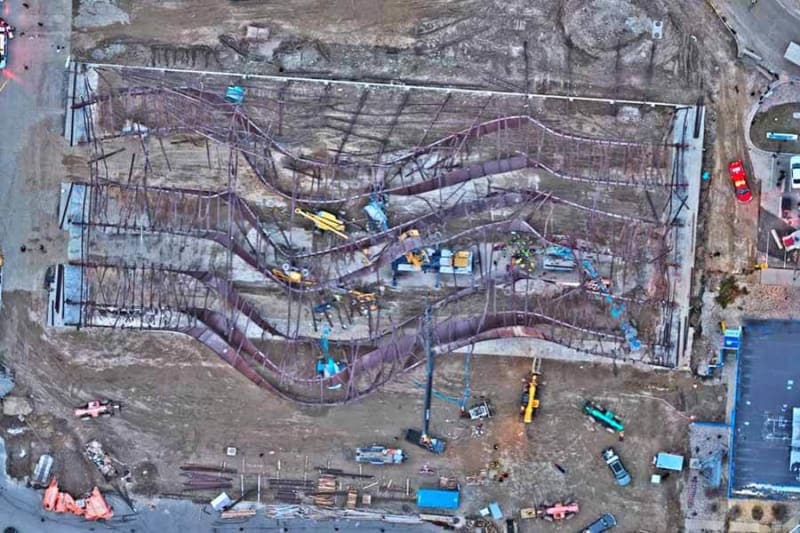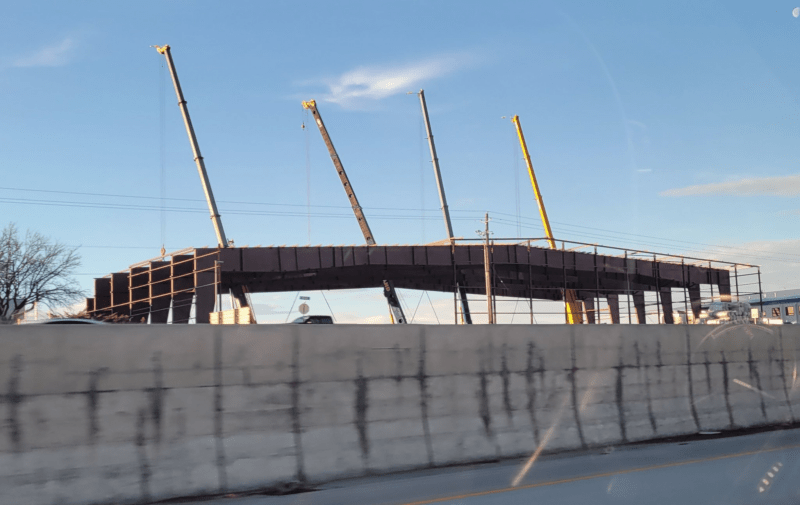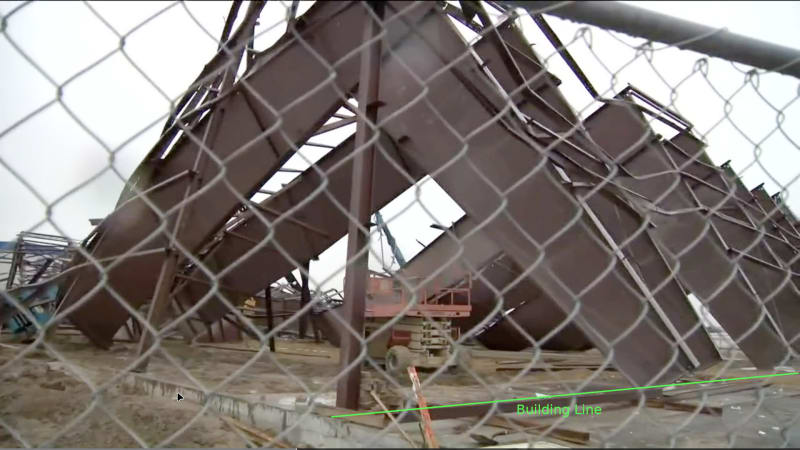Hangar under construction collapsed killing 3 and injuring more.
Navigation
Install the app
How to install the app on iOS
Follow along with the video below to see how to install our site as a web app on your home screen.
Note: This feature may not be available in some browsers.
More options
Style variation
-
Congratulations cowski on being selected by the Eng-Tips community for having the most helpful posts in the forums last week. Way to Go!
You are using an out of date browser. It may not display this or other websites correctly.
You should upgrade or use an alternative browser.
You should upgrade or use an alternative browser.
Boise Airport Hangar 7
- Thread starter TigerGuy
- Start date
- Status
- Not open for further replies.
-
1
- #42
I think we will find that Human99 has nailed the cause of the collapse. My guess is that a lot of these erection companies simply get lucky on the majority of the jobs. Beams of this span and slenderness are an accident waiting to happen. Much like long-span wood trusses. The byproduct of having a structure that relies so heavily on it being completed to be "stable"
From some dude on Reddit structuralengineering sub:
Link here. The OP took some more pics on site yesterday apparently. [URL unfurl="true"]https://old.reddit.com/r/StructuralEngineering/comments/1akovbf/boise_hangar_disaster/[/url]
Here's a video that the same OP took. Very nice. [URL unfurl="true"]https://www.reddit.com/r/StructuralEngineering/comments/1aku4oe/boise_idaho_hangar_video/[/url]
dualiecc(reddit) said:I know an operator that was on site that day. Wind picked up and they were scrambling to install guy wires and cross braces before the collapse. Said the building was making all sort of nasty noises then it was a massive all at once failure. Which in turn snapped the jib off the one crane at the mount.
Having been in the steel erection field my entire life these massive clear span structures leave very little room for error on erection. Without proper guys and stays there's nothing keeping the thing in plumb until it's sheeted
Link here. The OP took some more pics on site yesterday apparently. [URL unfurl="true"]https://old.reddit.com/r/StructuralEngineering/comments/1akovbf/boise_hangar_disaster/[/url]
Here's a video that the same OP took. Very nice. [URL unfurl="true"]https://www.reddit.com/r/StructuralEngineering/comments/1aku4oe/boise_idaho_hangar_video/[/url]
Typically PEMB bracing schemes are designed assuming load flow through planar paths (i.e. roof plane, wall plane). Since there was no cladding installed, wind pressure was applied directly to the face of the frame members instead of at the end wall framing roof connections. So the CG of the lateral load was eccentric to the assumed lateral load path plane of the roof. I do not think that exposed frame wind load case is explicitly designed for, which may be critical for deep members with large surface area and greater wind load-to-bracing plane eccentricity.
I would think the LTB cross bracing would be able to resist that applied torsion on the frames, but maybe they did not have all the bracing installed on every frame yet.
I would think the LTB cross bracing would be able to resist that applied torsion on the frames, but maybe they did not have all the bracing installed on every frame yet.
[URL unfurl="true" said:https://www.idahostatesman.com/news/local/community/boise/article284954822.html#storylink=cpy[/URL]]... Green, an ironworker from Mountain Home ... worried that, from looking at photos of the wreckage, he couldn’t see any guy wires, which are tensioned cables that add stability to freestanding structures.
Lack of guy wires is already becoming a theme.
Just thinking out loud here... say the LTB x-bracing was resolving the applied wind torsion up into the roof plane, the purlins would be acting as struts to drag that force into the roof x-bracing. I used to erect PEMB's as a laborer and remember not tightening purlin bolts right away, since we would have to remove them later when the lapped/nested purlins from the adjacent bay were installed. From the photos it looks like the adjacent bay purlins had not been installed yet, so maybe those purlins acting as structs to resolve the applied torsion did not have fully tightened bolts and popped off. Without the purlin struts, I believe the LTB cross bracing would just scissor and not be able to provide stability against global twist.
Everything seems to point towards this structure being very loose. Perhaps the crew was lulled into complacency after erecting similar scale structures with open web beams whose anchoring system and open webbing present a much different profile to the wind and its potential impact.
Significant updates last week as information is starting to become available and litigation efforts move ahead.
Beams were bowing and cross bracing cables snapped the day before.
AP via msn.com - Workers expressed concern ...
Idaho Statesman via msn.com - Lawyer holds press conference ...
East Idaho News - "Did not look right" ...

East Idaho News
Beams were bowing and cross bracing cables snapped the day before.
AP via msn.com - Workers expressed concern ...
Idaho Statesman via msn.com - Lawyer holds press conference ...
East Idaho News - "Did not look right" ...

East Idaho News
DMEPrecision's photo was taken the morning of the collapse. They were just starting to raise the final beam. If the structure was already bowed, it would have been awkward to brace the final beam to the others, at least if the bow was pushing through to or initiated in the south pair.
Once a structure of that mass deforms enough to snap the cross bracing, are they going to be able to pull it back into shape with a come along or would they need to utilize additional supports?
Once a structure of that mass deforms enough to snap the cross bracing, are they going to be able to pull it back into shape with a come along or would they need to utilize additional supports?
Depends on how bad the bowing becomes or when the braces snapped, but come alongs should be able to pull it back into shape, but this sounds like it could have been worse than just simple straightening if they required additional cranes on site to assist in straightening. I doubt they were hoisting and rotating to tension the beams, so they were likely also loosening connections.
Last time I was pulling a bent by 8" to straighten it out, down the bridge another crew broke some bolts loose while we had tension on come alongs and crane. In an instant we lost all tension and went for one hell of a ride as everything wanted to twist. I suspect something similar happened.
I can't those iron workers and 4 operators continued to work in a deadly situation if they had noticed it and reported it the day earlier.
Last time I was pulling a bent by 8" to straighten it out, down the bridge another crew broke some bolts loose while we had tension on come alongs and crane. In an instant we lost all tension and went for one hell of a ride as everything wanted to twist. I suspect something similar happened.
I can't those iron workers and 4 operators continued to work in a deadly situation if they had noticed it and reported it the day earlier.
Sym said:Once a structure of that mass deforms enough to snap the cross bracing, are they going to be able to pull it back into shape with a come along or would they need to utilize additional supports?
It can be done, but is also potentially very hazardous to the structure. Unless everything is tied back to a serious shear wall or stair tower or whatever, you're putting out of plane forces into the structure where those loads aren't designed to be picked up. It's like bracing a spaghetti noodle to another spaghetti noodle.
That is the crux of the matter. On these significant spans (I can think of one or more others), the wrong cost/benefit analysis is often performed. If one could just grab a 2x4 and prop it up until it was reset, no one would think twice. Add in additional costs, and the hedging begins.
Hello, I drive by this site at least every week. It’s saddening to think that people died at work, at that site in Boise.
I had driven by this site hours before the collapse. As driving pass the site, and I noticed the lack of flagging on the top of the four cranes that were actively lifting the beams in place. I questioned the knowledge of the site contractor just on airport flagging of cranes, to my wife.
Still looking at the cranes being used to raise the steel, I noticed one of the cranes was smaller than the other three, maybe 2/3 the size smaller than the other three cranes. You can see the different crane booms in the picture. See the photograph on DirteJoe post above.
Question, could this collapse happen from a damaged flange on one or more beams?
Seeing the twisted pile of steel every time we drive by, it still amazes me how the beams conformed to the crushed equipment laying beneath the steel.
I had driven by this site hours before the collapse. As driving pass the site, and I noticed the lack of flagging on the top of the four cranes that were actively lifting the beams in place. I questioned the knowledge of the site contractor just on airport flagging of cranes, to my wife.
Still looking at the cranes being used to raise the steel, I noticed one of the cranes was smaller than the other three, maybe 2/3 the size smaller than the other three cranes. You can see the different crane booms in the picture. See the photograph on DirteJoe post above.
Question, could this collapse happen from a damaged flange on one or more beams?
Seeing the twisted pile of steel every time we drive by, it still amazes me how the beams conformed to the crushed equipment laying beneath the steel.
A flange damaged to the extent that it leads to structural failure would be a significant issue but not something that would go unreported. I don't anticipate it being a factor here given what has been publicly disclosed. The bracing was already loose the day before the collapse and then heavier winds picked up and blew continuously on the day of collapse. It sounds like the job got away from the installers.
A shorter boom on a crane is not an indication of its capacity being exceeded. A crane with a longer boom can reach further away but at much a reduced capacity compared to lifts at close range.
A shorter boom on a crane is not an indication of its capacity being exceeded. A crane with a longer boom can reach further away but at much a reduced capacity compared to lifts at close range.
OSHA laying the blame on the contractor:
Link
I'll save my thoughts on PEMBs, but they are extremely scary while they're going up. Hopefully OSHA publishes the results of its investigation soon.
Federal inspectors found the company had started building the hangar without sufficient bracing or tensioned wires and that numerous indications that the structure was unstable and bending were ignored.
“The company’s irresponsible construction methods left the aircraft hangar’s structure extremely vulnerable,” Kearns said.
Link
I'll save my thoughts on PEMBs, but they are extremely scary while they're going up. Hopefully OSHA publishes the results of its investigation soon.
Sym P. le (Mechanical) 5 Feb 24 16:20 said:There was plenty of cross bracing employed during this operation, both across the main span, and on the verticals (heavier at the corners).
I stand corrected! ... although some bracing or tensioned wires were seen to be employed.
Idaho News 6 (Youtube) From day one of erection, issues were arising, yet they carried on without fully addressing the problems.
- Status
- Not open for further replies.
Similar threads
- Question
- Replies
- 12
- Views
- 14K
- Replies
- 18
- Views
- 989
- Locked
- Question
- Replies
- 7
- Views
- 657
- Locked
- News
- Replies
- 24
- Views
- 2K
- Replies
- 81
- Views
- 9K




